| << . 1 . 2 . |
| Author |
Message |
Just
Member
|
# Posted: 24 Jul 2014 10:48pm
Reply
Peace be with you ,brother !!
|
|
creeky
Member
|
# Posted: 25 Jul 2014 12:04pm
Reply
that bites. sorry to hear of your problems.
great pics tho. and I'll bet you're glad your panels are so far away.
How's the rebuild going?
|
|
MtnDon
Member
|
# Posted: 8 Aug 2014 06:44pm
Reply
Air terminals, assorted bases/mounts, clamps, clips and braided wire...
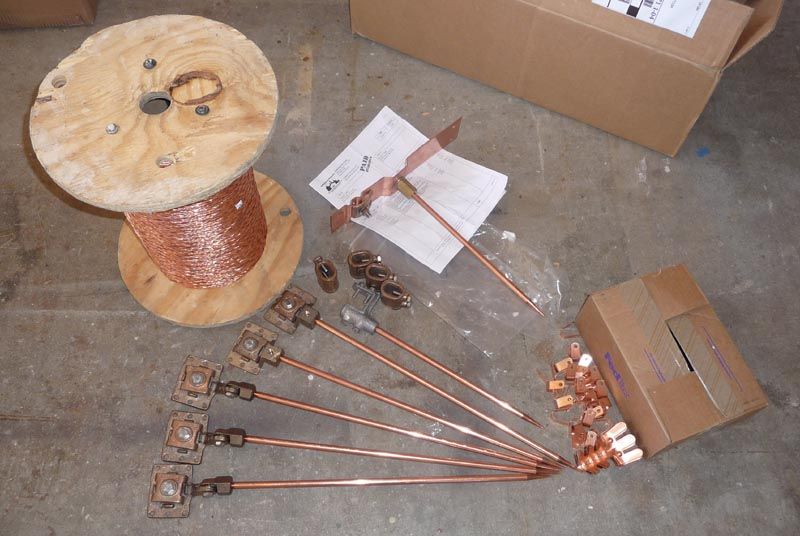
Next step will be the roof top for me. I've already driven some ground rods in place. Once the air terminals are mounted I'll connect the wires and do some photos.
|
|
bldginsp
Member
|
# Posted: 8 Aug 2014 08:23pm
Reply
Did you consider aluminum components for your system? I read somewhere that copper lightning rod components in contact with metal roofing can promote galvanic action that screws up the roofing, so I was going to look at the aluminum. Costs less, not as effective a conductor.
|
|
beachman
Member
|
# Posted: 8 Aug 2014 09:07pm
Reply
Sorry to hear about the strike and glad it wasn't worse. This is the one thing I was really concerned about since our place is at the edge of a lake and there can be some severe storms. I have been installing a solar system this Summer and while away I always disconnected the panel because I had not finished the grounding or installed the (Delta) lightning arrestor. Looks like my efforts may be in vain.
Initially no one talked about grounding, bonding and arrestors. After raking through the internet and some discussions here and to electricians, I slowly found out some basic things about grounding. It sounds like you were doing all of the right things but lightning is so unpredictable. I guess I will continue on my planned path and just hope for the best. Good luck to you!
|
|
MtnDon
Member
|
# Posted: 8 Aug 2014 09:38pm - Edited by: MtnDon
Reply
bldginsp , we considered aluminum. One drawback is that aluminum wire cannot be buried. It is recommended that the ground rods with clamp and connected wire be set one foot below the surface and covered over. That includes the wire and the clamp. So to do that you need to employ a proper Al to Cu transition connector. Those tend to be more pricy than a standard clamp. (The Al wire connects to a Cu wire about 2 to 3 feet in length and that connects to the rod clamp.). Some of the savings of the Al components disappears with each Al-Cu coupler. I wanted a rod at each corner so that be a minimum of 4 couplers.
The air terminals and all else are available in Al as well with some savings. The savings would have been about $90 on the $700 total cost of hardware. Not insignificant, but not a deal buster either. One must make a personal choice. I decided I did not want the extra electrical connections with the possibility of extra resistance.
The goal is to have less than 15 ohms, preferably less than 10 ohms resistance between the earth and the lightning protection wiring. We are placing some of the grounding rods in and near the waste water leach field on the south. On the north side we have no gutters and have a row of grounding rods along the drip line. That side is much more moist than the south side. I also have several 12 to 16 foot lengths of salvaged #2 copper wire that will be placed in trenches leading away from the grounding rods in a few spots.
Regarding galvanic action, there will be a square of sheet stainless steel and a layer of EPDM under each mount, secured with stainless steel screws.
|
|
bldginsp
Member
|
# Posted: 8 Aug 2014 09:42pm
Reply
Sounds like a good plan
|
|
MtnDon
Member
|
# Posted: 8 Aug 2014 09:48pm
Reply
beachman , IMO, swap the Delta equipment for Midnite Solar suppressors. They do cost more but they do have added circuitry that indicates when/if they become disabled, burnt out whatever. There is a pair of bright blue LEDS that indicate the suppressors are functional.
I had known about them and that they offer superior performance a year or so ago. I simply never got around to buying and installing them. Some folks including PV guru John Wiles of NMSU believe both should be used as they use different methods and under some circumstances one may be better than the other. I'll have suppressors/arrestors at the PV array, 300 feet down the DC line at the CC and at he inverter to service panel connection. I may add one at the generator as it is in the barn, away from the cabin, even though the wiring is underground.
|
|
|
MtnDon
Member
|
# Posted: 25 Aug 2014 09:59pm - Edited by: MtnDon
Reply
Just for the record, I am about done with the repairs and improvements. FWIW, in recap, here is what I have done.
Grounding improvements are in two separate sections; lightning rods or air terminals and grounding (earthing) the electrical system.
Air terminals. Four on the 16 x 30 cabin, 3 on the ridge and 1 on the S/S wood stove chimney. 26 strand 7/16" dia. wire used to connect all the air terminals. These extend down to the ground at diagonally opposite corners. Each wire first connects to an 8 ft. copper clad 5/8" dia. steel rod that is driven into a hole dug to make the bottom end of the 8 ft. rod 9 ft. below grade and set out from the cabin wall about 2 feet. The same wire is buried in a trench to run to a second rod about 10 feet distant on each side of the cabin. From that rod the wire extends another 10 feet or so to a 2 sq. ft. copper sheet buried about 2 - 2 1/2 feet down. All wires are covered with earth. The terrain was reshaped slightly in places to permit the collection of rain water and snow melt to soak into the soil and make a better ground electrical connection.
The shed (8 x 8) has a TV antenna mast that reaches a height of 24 feet above roof level. This mast is down wire connected to a ground rod. A wire connects this ground rod to one of the ground rods at the cabin, a distance of something like 15 - 16 feet.
The barn (larger shed, 9 x 16) has two air terminal on the high side of the shed style roof. These are connected with the same 7/16" wire as used on the cabin. Here too the down wires drop at diagonally opposite corners. There are 2 ground rods at each corner, placed about 10 feet apart. One of these ground rods is connected to the ground rod at the TV mast. So all ground rods are inter-connected for best performance. Resistance between 1st and 3rd adjacent ground rods ranges from 2 to 6 ohms. That may change over the span of the seasons. The ground is mosit right now. We'll have to resample later in the year and next spring and early summer. Several access points have been made to facilitate the re-measuring.
Electrical system grounding. This includes the ground rod system and the new surge suppressors or lightning arrestors.
I have Midnite Solar SPD's. One at the PV array combiner box. Another is 310 feet up the hill at a newly installed "power post" that is 10 feet from the cabin corner where the new Midnite Solar "The Kid" charge controller is located. A third MN SPD is located right at the CC input . A fourth is located at the DC wires that feed the inverter; this is a low voltage version as it is connected to the 24 VDC battery bank. Finally a fifth MN SPD is mounted at the AC service panel. At the PV array is also a Delta DC suppressor as well as a Delta AC version suppressor at the service panel. Nothing like redundancy.  And expense. And expense.  A cool thing about the MN SPD is they have an LED that indicates that it is operational. A cool thing about the MN SPD is they have an LED that indicates that it is operational.
Grounding. At the PV array I added four rods in a manner similar to the lightning air terminal system. That is rods connected to one another in a string with about 10 feet between rods. They extend to the pond area with the last rods directly parallel to the bermed low side of the pond. Probably the most moist area we have. At the cabin all the hardware from CC to inverter, battery charger and service panel are individually connected to a ground buss. One end of the ground buss is connected by #2 copper wire to a ground rod at the new power post. From there a series of 5 ground rods extend into the grey waste water dispersal field. On the surface a series of bowls, centered around the rod positions, serve to catch, retain and permit soaking in of any precipiation.
Presently we are using a backup Samlex 1500 watt pure sine wave inverter for the cabin AC power needs. It does mean having to think when using the microwave or electric kettle. It will do until we decide if we really need the power capacity and convenience of something like the 3500 watt Outback that was toasted.
Lastly there does appear to be some hidden wiring damage in one of the lines to or between the gazebo, shed and/or barn. On occasion the GFCI that feeds that low use line trips. Sometimes it will not reset, sometimes it will reset several days later. The GFCI itself is good. It will be a tedious task to track down. Hopefully I'll track down the fault earlier rather than later. That's the Labor Day weekend project.
|
|
MtnDon
Member
|
# Posted: 26 Aug 2014 09:25am - Edited by: MtnDon
Reply
I forgot to elaborate on a feature new to the PV system. Why did I install what I call the power post 10 feet from the cabin? It is to make it easy to physically disconnect the DC lines from the PV array to the charge controller. The suggestion came from my friend Dave, a solar expert. Lightning can easily jump the small gap in a circuit breaker that is turned off. Now if the threat of lightning is imminent we can shut of the PV power feed with ease, disconnect the wires and pull them aside creating a large physical gap. During lightning season when we are absent we can leave the system disconnected. Just an additional preventative step. Most of the year, like fall through spring there is little lightning action likely so I feel safer leaving the system up and running then. Our absences in lightning season are short enough and no power is used from the batteries at all at those times that I feel there is little danger from battery self discharge.
|
|
creeky
Member
|
# Posted: 26 Aug 2014 07:20pm
Reply
MtnDon. I would pull that GFCI. I've had personal and expensive experience with a gfci that worked except when it didn't. for the cost. pull it and get a new one. my .02. certainly I pulled a "possibly defective" and haven't had a problem since the new one went in.
You might have a look at the european tbs inverter/chargers. they look to be well built. oh wait. you have a samlex. the tbs is sold under the samlex name.
do you think that the power surge you experienced was lightening down or lightning ground up? certainly you describe the trees as being burnt (down) and when you look at the damage (ground up) it looks like it could have come from the ground. i say this because a scientist warned me about the effect and it certainly sounds like what you see in your damage report.
interested in your thoughts.
|
|
MtnDon
Member
|
# Posted: 26 Aug 2014 09:10pm - Edited by: MtnDon
Reply
I should have phrased my comment about the GFCI differently... That unit was newly installed 2 to 3 weeks ago, right after we discovered the lightning damage. It strangely works fine when fed by the Honda EU2000i. All outlets down stream work fine too. But half (?) the time when the Samlex inverter is supplying the AC power that GFCI trips immediately. And then it works fine for a day. The next time the inverter is turned on it may trip again. A branch of the line it serves is to the gazebo where there was a conduit elbow that blew up.
Anyhow when we get back there I'll start troubleshooting. I have another new GFCI I'll try just because it is something to doublecheck.
~~~~
I've talked with some engineer friends at LANL They tell me we were likely hit with some positive lightning. Most lightning is negative, appears to move down. Positive is rarer, maybe only 5%. Positive strikes can contain as much as 60 times as much energy and have a longer duration, 5 to 10 times longer. They do a lot more damage. The lightning maps for our area on the evening when we suspect the damage was done indicate 90 strikes within about 45 minutes. The maps are accurate to within 200 meters, a big enough area to be sure, but still a lot of strikes in a short period. The instruments indicate 6 strikes as being positive. Positive strikes are also more likely to be a bolt out of the blue, striking on the outskirts of the storm action.
The mapping service they use requires membership and is not available to the general public... Rats! There are some public access sites but not with the detail available to those in government or with other paid access.
So anyhow it seems like there was a lot of assorted lightning occurring that evening. We were unlucky enough to be too close.
~~~~
I am also going to have the damaged Outback VFX inverter looked at for an estimate. It does not seem to be as badly damaged as the FM60 CC was. That thing had all sorts of silica and scorched metallic bits rattling around inside. The VFX are a totally better inverter when compared to the Samlex. But then I guess I got spoiled with the fine tunability and rapid start of their sleep system, the ramp up the VFX charger goes through when activated, and so on.
I may as well add that the MN Kid CC is a very nice piece of work. It does it all w/o the need for a ventilation fan. Just a die cast aluminum chassis and heat sink.
|
|
MtnDon
Member
|
# Posted: 30 Nov 2014 08:41pm
Reply
Better late than never???
Pictures of the completed LPS. I neglected to take in progress shots.
The east gable end showing an air terminal and part of the down wire run.
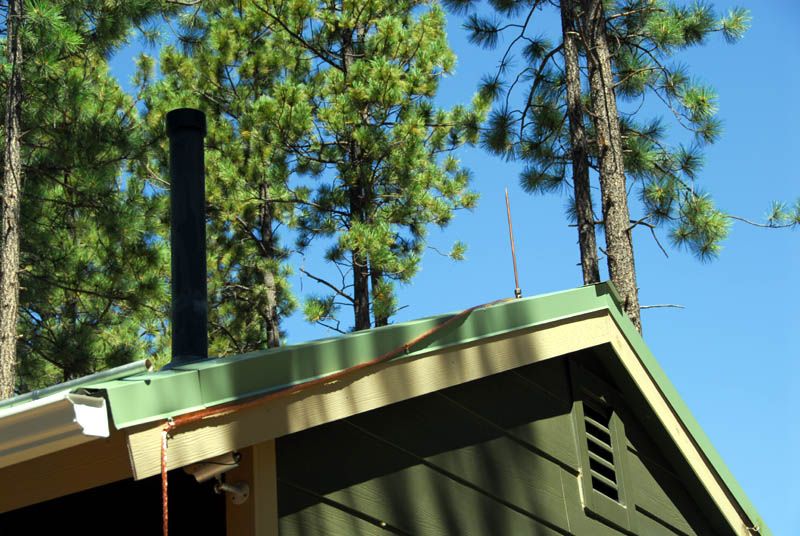
18 inch air terminal, closer up
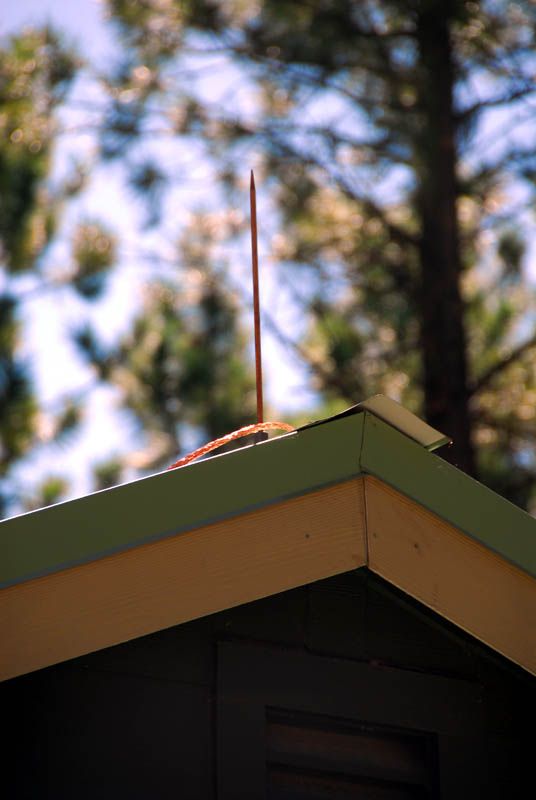
East end again. The air terminal is barely visible. The drop wire falls straight down into a hole with the ground rod driven down one foot below the surface. The down wire continues south in a trench to another ground rod approx. 15 feet from the cabin. Then it continues south for another 12 or so feet to a buried 2 ft sq copper ground plate. That is next to a wet area where the grey water terminates.
In the foreground is the new "power pole". The wires from the PV arrive underground and come up to a disconnect in the box. There is a Midnite Solar SPD (surge protection device, aka lightning arrestor) connected to the incoming wire there. On the other side of the post is a outlet for the DC line to the charge controller. It is a locking plug/socket. When in lightning season we can disconnect when we leave or if we are present we can disconnect when lightning threatens.

Close up of the plug end and the warning labels.
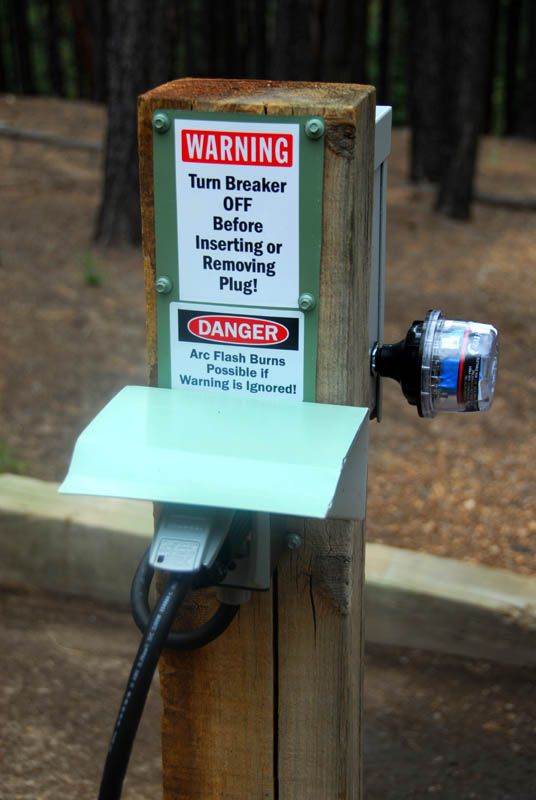
New SPD on the service panel
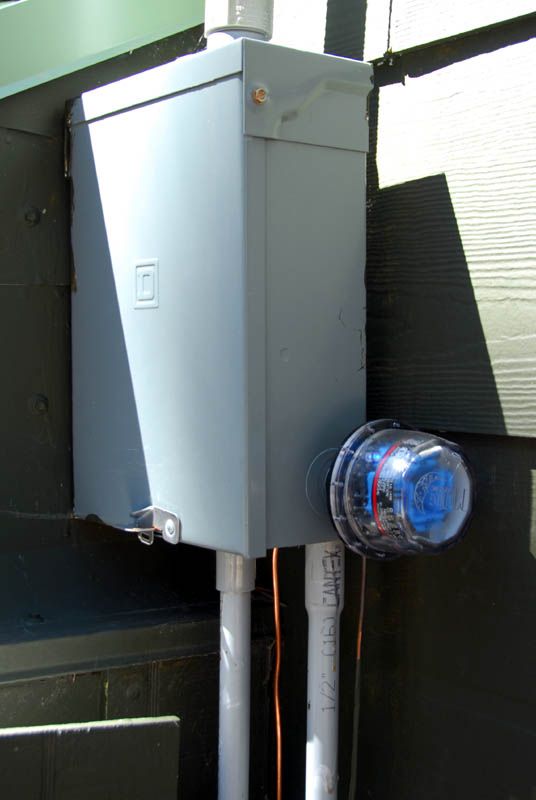
Ground down wire on the west end. As with the other end this connects to a ground rod driven one foot below surface. The wire then continues, unbroken, to another rod and a ground plate down the side of the cabin.
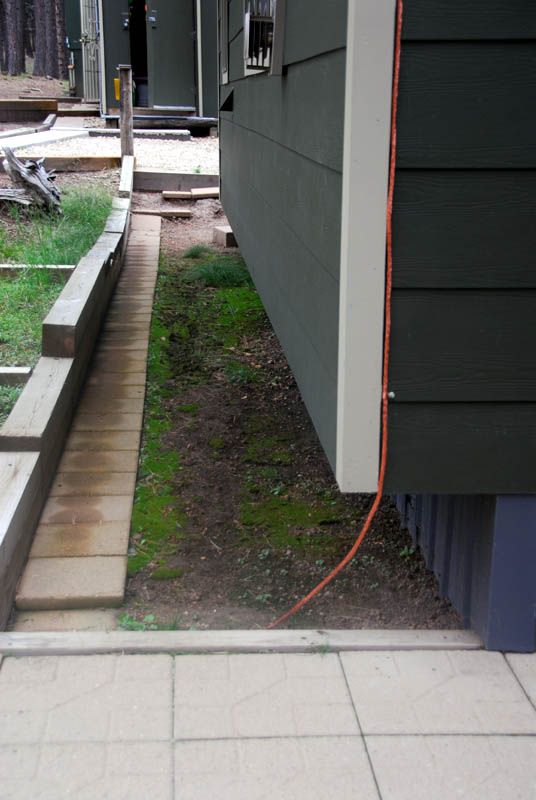
|
|
Just
Member
|
# Posted: 30 Nov 2014 09:57pm
Reply
You should be much better protected now,, nice neat job ..
|
|
toyota_mdt_tech
Member
|
# Posted: 1 Dec 2014 09:49pm
Reply
MtDon, I took a hike up to a fire lookout, climbed up and inside of it (First butte lookout, Okanogan National Forest). They had that solid #4 copper wire. This was a squarish house high on a wooden tower with a full perimeter porch. The #4 copper wire was wrapped all around the edge of the hip type roof, ran up each ridge to the top center. The porch railing had the copper on the outer edge, then all sections were tied together on every corner, then the heavy wire ran down each tower leg. All were tied together again at the bottom with a ground rod in each corner.
|
|
| << . 1 . 2 . |

